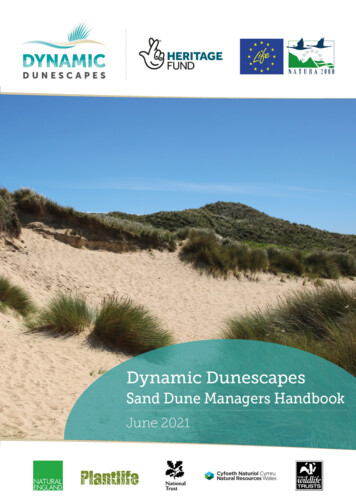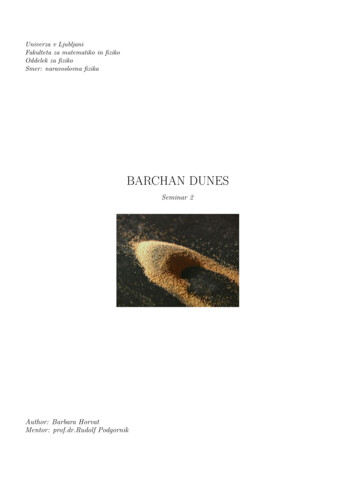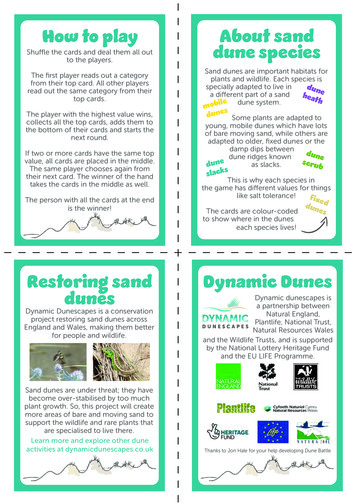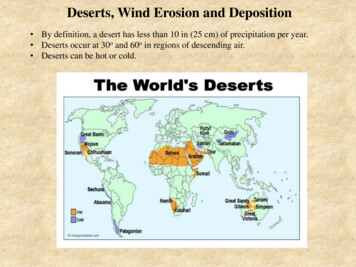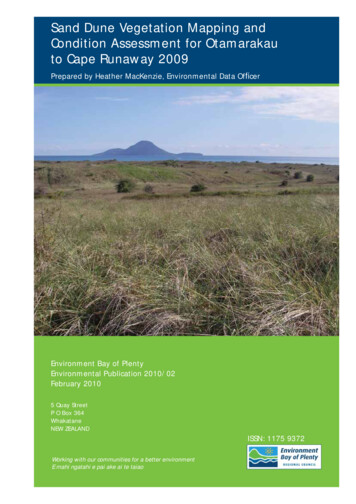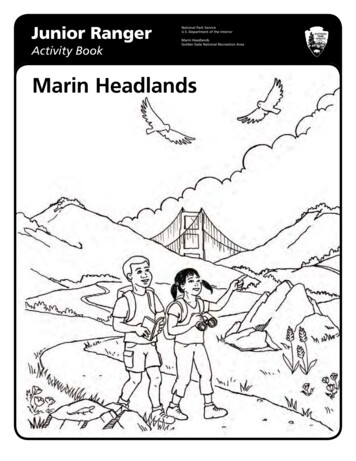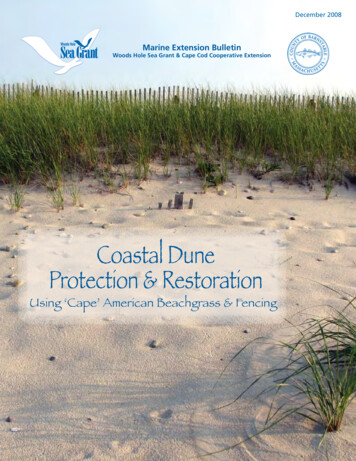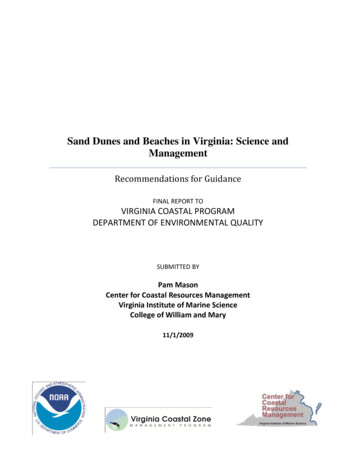
Transcription
Sand Dunes and Beaches in Virginia: Science andManagementRecommendations for GuidanceFINAL REPORT TOVIRGINIA COASTAL PROGRAMDEPARTMENT OF ENVIRONMENTAL QUALITYSUBMITTED BYPam MasonCenter for Coastal Resources ManagementVirginia Institute of Marine ScienceCollege of William and Mary11/1/2009
Table of ContentsIntroduction. 2Definitions . 3Beach. 3Coastal primary sand dune . 3Coastal Primary Sand Dunes and Beaches in the Ecosystem . 5Coastal Hazard Protection. 5Habitat . 6Water Quality . 7General Criteria for Beach/ Dune Projects . 8Preference for sustainable actions . 8Specific Criteria for Beach/ Dune Projects . 9Stabilization Methods . 9No action, maintain or enhance natural dune/ beach features. . 9Non-structural techniques, including sand fencing . 9a. Sand fencing. 9b. Beach Nourishment . 9Combined non-structural and structural techniques . 10a. Breakwater . 10b. Groins . 10Structural techniques . 10a. Revetment . 10b. Bulkhead . 11Residential, Commercial & Accessory Structures . 12Beach Access Structures . 12Dune Leveling & Relocation . 12Dredging on Sand Beaches . 13Dune Restoration . 13This project was funded, in part, by the Virginia Coastal Zone Management Program atthe Department of Environmental Quality through Grant #NA07NOS4190178 of the U.S.Department of Commerce, National Oceanic and Atmospheric Administration, under theCoastal Zone Management Act of 1972, as amended.1
Sand Dunes and Beaches in Virginia: Science and ManagementIntroductionSandy beaches and dunes provide a natural buffer to coastal hazards, habitat for manyestuarine species and water quality services. While there are places in Virginia wheresand is seemingly abundant, natural forces and human decisions act to limit availablesand. Shoreline hardening, bank grading and dredging are among those actions that canresult in loss or reduction in sand supply. Less sand means fewer and smaller beaches andsand flats. And as downdrift beaches and sand flats diminish, there is a loss of erosionprotection for real property and infrastructure and adverse impacts on ecosystem servicesincluding recreation.The importance of sandy shores was recognized with the passage of the Coastal PrimarySand Dune Protection Act in 1980. Eight localities were included in the Act: the countiesof Accomack, Northampton, Mathews, Lancaster, and Northumberland; and the cities ofVirginia Beach, Norfolk, and Hampton. The Act also defined a beach and coastal primarysand dune and included a list of those plants which grow upon the dunes.Along the way, the name of the Act was changed to The Coastal Primary Sand Dune andBeach Act. The purview of the Act was notably modified during the 2008 Session of theGeneral Assembly. The list of local governments authorized to administer the Act waschanged from the eight originally specified to include all of Tidewater Virginia asdefined in § 28.2-100 of the Virginia Code.The 2008 changes also added three plant species to the list of dune plants named in theCoastal Primary Sand Dune and Beach Act that are necessary for jurisdictionaldeterminations. The three plants added to the list are the nonnative Japanese sedge(Carex kobomugi), the native Virginia pine (Pinus virginiana), and the native broomsedge (Andropogon virginicus).Natural sand features, beaches and dunes, are part of a shoreline system that can extendfrom uplands and eroding banks out to sand bars in nearshore shallow waters.Interactions between these features are critical to the sustainability of the system.An improved scientific understanding of sandy shorelines in Virginia includes betterinformation on the presence of these types of shorelines throughout Virginia andrecognition of the need to manage these valuable resources wherever they occur.Effective management will require an understanding of physical processes and ecologyand the effects that shoreline activities have upon those processes.2
DefinitionsBeach means the shoreline zone comprised of unconsolidated sandy material uponwhich there is a mutual interaction of the forces of erosion, sediment transport anddeposition that extends from the low water line landward to where there is a markedchange in either material composition or physiographic form such as a dune, bluff, ormarsh, or where no such change can be identified, to the line of woody vegetation(usually the effective limit of stormwaves), or the nearest impermeable man-madestructure, such as a bulkhead, revetment, or paved road.Coastal primary sand dune or dune means a mound of unconsolidated sandy soilwhich is contiguous to mean high water, whose landward and lateral limits are marked bya change in grade from ten percent or greater to less than ten percent, and upon which isgrowing any of the following species: American beach grass (Ammophila breviligulata);beach heather (Hudsonia tomentosa); dune bean (Strophostyles spp.); dusty miller(Artemisia stelleriana); saltmeadow hay (Spartina patens); seabeach sandwort(Honckenya peploides); sea oats (Uniola paniculata); sea rocket (Cakile edentula);seaside goldenrod (Solidago sempervirens); Japanese sedge or Asiatic sand sedge (Carexkobomugi); Virginia pine (Pinus virginiana); broom sedge (Andropogon virginicus); andshort dune grass (Panicum amarum ). For purposes of these guidelines, "coastal primarysand dune" or "dune" shall not include any mound of sand, sandy soil, or dredge spoildeposited by any person for the purpose of temporary storage, beach replenishment orbeach nourishment, nor shall the slopes of any such mound be used to determine thelandward or lateral limits of a coastal primary sand dune. § 28.2-1400 Code of Virginia.3
Figure 1. Beach and Beach/Dune jurisdictions.4
Coastal Primary Sand Dunes and Beaches in the EcosystemCoastal Primary Sand Dunes and beaches perform a host of ecological services thatbenefit adjacent ecosystems as well as the human inhabitants of these areas. As impactsto these areas represent both an ecological and an economic impact, any proposedactivities should be examined carefully to weigh the consequences for both public andprivate interests in these areas.On sandy shorelines, sand moves both across and along the shoreline. Sand movesbetween dunes, beaches, nearshore flats, and off shore sand bars. There is a seasonalelement to the sand distribution with steeper beach slopes in winter and gentler slopes insummer. The sand on the shoreline may come from various sources including farupstream, nearby eroding bluffs, off shore and even downstream sand carried by tides.The primary physical factors that influence the shape and composition of beach andbeach-dune shorelines are waves and wind. The transport of sand by wind is calledaeolian transport. Waves and wind also create conditions that have the potential to causeloss or damage to real property and infrastructure. And these factors influence theecosystem processes and services provided by beach and beach-dune systems.Ecosystem services can be grouped into 3 categories as follows:Coastal Hazard Protection (Erosion protection)Habitat, andWater Quality.Coastal Hazard ProtectionCoastal primary sand dunes and beaches serve as protective barriers to flooding watersand wind and wave generated erosion. The presence of beaches or beaches and dunesserves as a first line of defense against wave and wind energy.Beaches provide a buffer to wave energy. As waves approach the shallows, the waveslows on the bottom due to friction and the top “spills” over (or breaks). The breakingwave transfers energy to the beach before coming in contact with the upland. The beachsand allows water to “perk” into the beach and return to the waterway below the surface.This process reduces the energy at the surface that could erode sand from the beach.The physical presence of the dune provides a wind break reducing wind energy and itspotential adverse effects on nearby property. The vegetation on the dune providesadditional friction to slow the wind and also traps sand being carried by the wind.Trapped sand acts to build new dunes and maintain existing dunes. Notably, dunes alsobehave as levees in the face of storm water.Features on sandy shorelines, including primary and secondary dunes, berms, beaches,nearby sandy banks and nearshore sand bars serve as reservoirs of sand. Sand movement5
occurs between these features. Sand movement occurs along and across (on-and offshore) the shoreline. Sources of sand for riverine beaches also include eroding banks andbluffs that contain sandy material. Maintenance of beaches and/or dunes wetlands isdependent upon available sand supply and the capacity for sand to move among theseshoreline features.HabitatDunes and beaches provide habitat for a variety of plants and animals. Plants adapted forlife on coastal primary sand dunes survive in the face of very limited amounts of freshwater, constant salt spray, and marked variations in temperature. Endemic plants andanimals, those that live only on beaches and dunes, are adapted to these physical stresses.Species of worms, bivalves, isopods and crustaceans live in the spaces between the sandgrains on the beach, the interstitial spaces. These animals, called infauna, rely on theorganic material delivered by waves that filter through the beach. Animals that occupythe beach are highly adapted to extreme conditions of physical disturbance. Becausegrain size affects the water chemistry, oxygen content and organic matter content of thebeach, it also determines the species of animals and numbers of individuals. The greatestnumbers of species and individuals are found on intertidal areas with sand of varioussizes along with some finer sediment - silts and clays.The infauna are an important food source for foraging fish and crustaceans that are on thebeach at high tide, and wading shorebirds.Many species use the beach and/or dune for nesting, feeding, corridors, nursery or refuge.Some animals on the beach and dunes, or the adjacent waterways, may be rare,threatened or endangered. Limitations in scope, scale or time may be placed on activitiesor projects that could have an adverse effect on these species. Time of year restrictionsmay be required to avoid adverse effects during particularly vulnerable life stages ofcertain animals.Gloucester County Beach6
Water QualityBeaches and dunes provide water quality services through water filtration, nutrientcycling, nutrient uptake and water storage.Waves wash over intertidal beaches and large volumes of water sink into the sand. Thisprocess filters particulate and dissolved organic material from the water. The organicmatter is delivered to the interstitial animals (those living in the spaces between the sandgrains). Beaches with sand particles of varying sizes, including small fractions, retain thegreatest amount of organic matter. As such beaches with varying sized sands are mosteffective at removing organic matter from ambient waters.While ambient waters may be a source of organic matter, beaches have little primaryproduction and are generally nutrient poor. Nutrients deposited on the beach are quicklyprocessed. Nitrogen is cycled through the beach by the following processes:It is returned to the waterway from tidal and groundwater flushing,It is trapped in the beach and used by microbes or in-faunaIt is transferred to the groundwater, orIt is removed from the system by bacteria that convert organic nitrogen to N2 gas.This process is called denitrification.On the vegetated portions of the sandy shoreline, plants remove nutrients through theproduction of plant material. Some of this plant material is directly consumed by insectswhich are eaten by other animals forming part of the coastal food-web. Primaryproduction not directly consumed provides detritus to the waterway and organic matterfor the interstitial fauna on the beach.The low areas between dunes, know as swales, are often areas of ground water discharge.Sufficient amounts of water in the swales can support the presence of a wetlandcommunity that can act to remove nutrient and other pollutants from the groundwater.The groundwater may discharge on the beach or in the nearshore.Essex County Beach7
General Criteria for Beach/ Dune ProjectsPreference for sustainable actionsCoastal shorelines and nearshore shallow waters tend to be dynamic and interconnectedwith the surrounding landscape and vegetative and animal life. Any action on one part ofthe system not only results in direct impacts to that habitat, but has the potential to impactadjacent habitats. Therefore, activities that impact shoreline should be avoided wheneverpossible.To reduce the cumulative and secondary impacts of activities within the multiplejurisdictions and management programs affecting the littoral and riparian zones, bettercoordination and integration of policies and practices is necessary. When makingdecisions regarding beaches and dunes, it is important to optimize water quality, habitatfunctions and coastal hazard mitigation/erosion protection across the entire cross-shoreenvironment. Special emphasis should be placed on the preservation or enhancement ofattributes (such as dunes, sandy beaches, riparian vegetation and wetlands) that contributeto ecosystem services.1. The following should be avoided: Placement of non water-dependent structures on dunes or beachesExcavation of dunes or beaches2. Adverse impacts of projects should be minimized by appropriatelydesigning and constructing for the physical setting.3. Time of year restrictions should be applied, as necessary, based uponproject location and extent.King George County Beach8
Specific Criteria for Beach/ Dune ProjectsStabilization MethodsThe natural position of a dune at any given time is the result of a balance of wind, wavesand storms. Dynamic processes along a sandy shoreline include continuous sandmovement between offshore sand bars, the beach and the dune. This sand movement iscritical to dune creation and maintenance processes. Structures to stabilize a dune orbeach in a particular location inhibit this natural fluctuation and buffering capability.Reflected wave energy can increase beach erosion and loss and adversely impact habitatfor beach-dependent species. Generally structures are not advised on the dune face, dunecrest or beach backshore.Stabilization methods that maintain or enhance the natural dynamics of the beachdune ecosystem are preferred. Management approaches can be grouped in order ofpreference as follows:1)2)3)4)No action, maintain or enhance natural dune/ beach featuresNon-structural techniques, including sand fencingCombined non-structural and structural techniques, andStructural techniques.No action, maintain or enhance natural dune/ beach features.Erosion control efforts should be avoided unless there is a risk of significant loss ofproperty and upland improvement. Activities to restore or enhance the ecology of theshoreline by planting dune vegetation may be possible.Non-structural techniques, including sand fencinga. Sand fencingSand fences help build dunes by trapping wind-blown sand. If installed improperly, theycan impede public access to the beach and wildlife movement.Sand fences in the Sandbridge area of Virginia Beach should comply with guidelinesadopted by the City of Virginia Beach, the US Army Corps of Engineers and theSandbridge Civic League.b. Beach NourishmentAlthough the placement of sand on the beach can enhance erosion protection, it can alsoimpact habitat of protected species (e.g. sea turtles, Northeastern beach tiger beetle).Existing dune vegetation may be buried. Manipulation of beach fill may also result inartificial dune lines that are not reliable indicators of suitable building and accesslocations. Temporary water quality impacts are also likely and may be widespread inboth area and time if the fill contains a large amount of fine-grained material and it isexposed to wind or wave erosion. Additionally, adverse impacts associated with the use9
of fine-grained material include flattening of the foreshore slope, increased aeoliantransport upland, greater changes in the beach profile and changes in the species andnumber of animals living within the beach.When the proposed project is for shoreline protection, beach nourishment is the preferredapproach for sandy shorelines as it enhances the natural capacity of the beach to providethe desired erosion protection. The maintenance of the beach may require the use of arock structure, such as a nearshore sill or offshore breakwater(s), and maintenancenourishment efforts.Only clean sand fill that contains at least 90% coarse-grained sand should be used. Timeof year restrictions may be required for protected species. The nourishment area shouldbe stabilized with appropriate vegetation.Combined non-structural and structural techniquesa. BreakwaterBreakwaters are comprised of two elements: one or more free standing structuresplaced in the nearshore waters, and sandy material used as beach nourishment. Beachnourishment is a preferred approach for sandy shorelines as it enhances the naturalcapacity of the beach to provide the desired erosion protection.Breakwaters cause the conversion of nearshore shallow waters to rock, or othernon-native material, and sandy shoreline. The construction of the breakwater will causetemporary water quality impacts and may interrupt sediment transport. Breakwaters aremost effective on high energy sandy shorelines and when designed for longer sections ofshoreline.b. GroinsGroin(s) will, by design, interrupt sediment transport along the shore. This will likelyresult in a loss of sediment on the down drift side of the groin, increase the erosion risk,and increase the loss of shoreline habitats.The creation of new groin fields should be avoided. However, the placement of a groinor groins may be a preferred alternative within an existing effective groin field with anadequate sand supply. Beach nourishment with clean, properly sized sand isrecommended for proposed groin projects.Structural techniquesa. RevetmentRevetments sever the connection between the nearshore bars, the beach and the beachberm or dune. Placement of a revetment within this cross-shore area will have adverse10
effects on the movement of sand both across and along the shoreline and is a change fromnatural sand and vegetation to rock. The result is a loss in the water filtration capacity ofthe beach/dune, a reduction in sand availability to nearby shorelines, a loss of erosionbuffering capacity and a change in the animal habitat.Revetments should not be placed on the dune face, dune crest or beach backshore. Ifused as the core of a constructed dune, rock structures should be buried with adequatevolumes of sand and planted with dune vegetation. Existing dune features disturbed byconstruction activity should be restored.b. BulkheadVertical bulkheads constructed along the beach interfere with natural coastal processessuch as the natural movement of sand between the beach and the dune, disturb valuablehabitat, are subject to failure from shifting and eroding sand, and may not provide theintended shoreline protection during extreme storm events.Bulkheads change beach profiles, alter the movement of waves along the shoreline andmay cause increased erosion on neighboring properties. Bulkheads may contribute totheir own destruction by reflecting waves and eroding the shoreline on the water side ofthe structure and are subject to overtopping and failure during storm events.As a matter of public policy, HB2586 validated the use of bulkheads for erosionprotection in Sandbridge Beach Subdivision in the City of Virginia Beach. Virginia Code§ 28.2-1408.2.Bulkheads adversely affect beach and dune ecosystem processes. Bulkheads are not resilient andtypically fare poorly in the face of the moderate to high energy found in beach environments.11
Residential, Commercial & Accessory StructuresStructures interfere with wind and sand deposition patterns adversely effecting sandmovement along and across the shore and natural dune building processes. Structuresmay be subject to burial, resulting in frequent excavation and movement of sand whichreduces stability of the dune and the amount of sand available for flood and erosionprotection. Structures may also shade or displace dune vegetation.All structures should be located landward from the beach and/or dune system. If duneencroachment is necessary, then the footprint should be minimized and limited to thedune backface (the back slope of the dune). Since the dune backface is the most activesand deposition area, only elevated open-pile construction should be used; slabfoundations and other structures that require excavations should be avoided. If sand mustbe excavated, it should remain in the local vicinity and be strategically placed andstabilized with vegetation to enhance the existing beach and dune features.Beach Access StructuresPedestrian or vehicle traffic access points through the dune will create a breach for windand waves through the dune line.Walkways & decks over dune vegetation will have shading impacts. Access structuresare subject to failure, particularly during storms, resulting in scattered solid waste debris.Elevated open-pile structures are preferred to minimize disturbance of vegetation andnatural dune building processes. The footprint of the structures should be the minimumnecessary to provide the desired access, this mean as direct and narrow as possible. Theelevation depends on dune crest and vegetation height. Designated access points arepreferred over multiple paths or elevated walkways. Construction mats placed on gradecan be used for temporary vehicle access.Dune Leveling & RelocationLeveling a dune eliminates the storm and erosion buffering capability and reduces theamount of sand available for the nearby beaches. These losses occur not only at the site,but for adjacent areas as well. If dune vegetation is removed, then the associated sandaccretion, stabilization and habitat functions are also reduced.Dunes should be maintained as a relatively uniform, uninterrupted dune line in order tooffer the maximum flood and erosion protection. Relocating part of a dune line creates abreach and hazard for property behind the relocated dune and adjacent properties.Dune alterations are not advised. If they are considered necessary, then sand should bestrategically placed and stabilized with vegetation to enhance natural beach and dunefeatures.12
Dredging on Sand BeachesDredging to remove sand or change sand transport patterns to maintain navigationchannels reduces the sand supply available for storm protection and interferes withnatural dune building processes. Dredging on sand beaches should be avoided. Sandbypass systems should be considered.Dune RestorationActions to create more extensive, better-stabilized dunes are generally beneficial. Theyshould be designed to enhance natural dune lines, height and vegetation communities.Clean, coarse-grained sand should be imported from an upland source rather thanborrowed from existing beaches and dunes.13
sand dune" or "dune" shall not include any mound of sand, sandy soil, or dredge spoil deposited by any person for the purpose of temporary storage, beach replenishment or beach nourishment, nor shall the slopes of any such mound be used to determine the landward or lateral limits of a coastal primary sand dune. § 28.2-1400 Code of Virginia.
